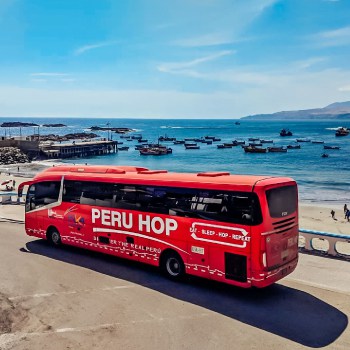Kuelap: The Machu Picchu of the North
Among the clouds of the Peruvian Andes above the Amazon Rainforest, you’ll find the magnificent Archeological Complex of Kuelap, one of the oldest and biggest historical structures in South America and known as the “Machu Picchu of the North.” This pre-Inca complex is located in the province of Luya and is about two hours from the town of Chachapoyas at an altitude of 3000 meters above sea level.
The walled city consists of more than 400 rustic buildings that were built in the 6th century AD by the Chachapoyas culture. This incredible site offers visitors surreal views of the cloud forest and surrounding countryside. Due to its structure and precise location, this pre-Inca complex served as a fortress to protect against invasions from other tribes in the area.
The fortress overlooks the Utcubamba River and although it may look like undiscovered ruins in the woods, Kuelap receives more tourists each year. Last year, around 84,156 people visited Kuelap in part due to the new cable car system that made it possible to arrive at the summit in just 20 minutes.

Kuelap’s Discovery
Due to the dense vegetation, difficult-to-access location, and heavy rainfall, this magnificent complex was left undiscovered for many years. Kuelap was finally found on January 31st, 1843 by Juan Crisostomo Nieto, judge of the nearby town of Chachapoyas, while wandering through the zone.
Afterwards, many researchers came to visit Kuelap in order to research the people who lived there and their culture. It was the historian Federico Kauffmann Doig who contributed the most to Kuelap research thanks to his passionate dedication to studying the Chachapoyas culture.
Most Important structures in Kuelap
- The Main Temple: This is one of the most important sacred centers in Kuelap. An abundance of evidence suggests that this place was used for sacrifices and complex rituals involving the placement of human bones inside a receptacle, creating a kid of ossuary.
- The Circular Platform: This place’s function was intimately linked to the Main Temple, as the home of the temple’s caretaker. In addition, the platform was the center of a huge massacre orchestrated around 1570 by Spanish Colonists.
- The Grave of the Inca of the Alto Sur Village: The grave was found inside a special structure, where the bones of a teenage Inca were accompanied by precious offerings like fine ceramics, wooden products and a metal nose ring. It’s possible that the offerings were part of the Capacochas ritual, an important Inca custom.
- Callanca: This building from the Inca’s time is one of the largest structures in the complex. It served as a ceremonial center as well as a lodging for guests and travelers.
- The Torreón: This structure was built on the second level, very close to the north zone of the complex. Seven meters height, it’s considered the highest building of Kuelap. Its believed that the structure was used as a defense wall for the city due to the spectacular panoramic view of the zone, allowing sentries to see possible attacks from adjacent villages.
- The Castle: Featuring a rectangular-shaped design and three platforms, this structure was the home of an important religious leader for the people of Kuelap.

Kuelap Cable Cars
There used to be just two ways to get to Kuelap: by car or by hiking, covering a distance of 37 kilometers from the town of Nuevo Tingo and taking from 2 or 5 hours. A new Kuelap cable car system was inaugurated in 2017. This new system covers a distance of 4 kilometer and takes just 20 minutes, giving travelers the opportunity to experience amazing aerial views of the zone.
The system offers a unique experience that represents the mixture of two words: the nature of the Tingo Valley sitting at the meeting point of the Andes and Amazon jungle, and the modern world expressed in the engineering of the new cable cars.
The public open hours are from 08:00 am to 4:00 pm and there are buses available every 10 minutes to bring you to the cable car station from Nuevo Tingo (the frequency of the buses varies depending of the season). The price of the cable car ticket is s/20 (a little under $6). When planning your visit, you should make sure to take into account that the service (bus and cable car) takes around one hour in total, and that Kuelap tours can take from 3 to 4 hours.
Turk kari koca ifsa
Koca götlü karılar resimleri
dünyanın en güzel seks pornolarını izle
Kuzenini aşık eden sarışın fıstık
bedava azdırıcı kız pornosu izle
Eve gelen tamirci tahrik etme
Sıkış sex am got
When to Visit Kuelap?
As Kuelap has dense vegetation and a very rainy climate, it’s recommended to visit the Archeological complex from May to September during Peru’s dry season.
Important Facts
- The Kuelap fortress was awarded the designation of Best Overseas Attraction in the National Geographic Traveler readers choice awards in 2017.
- The Kuelap Archeological Complex was declared a National Cultural Heritage in Peru in 2017.
- It is believed that the name Kuelap comes from a variation of the word “Cónlap” referring to the name of a small village that used to exist in the region.
Don’t Miss Kuelap
Kuelap is a must-see destination for any trip to Northern Peru. Don’t miss the opportunity to visit the “Machu Picchu of the North” and see a more off-the-beaten-track part of the country. You’ll fall in love from the moment you step foot there!










